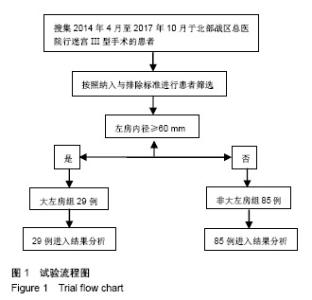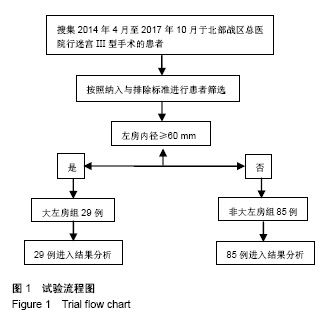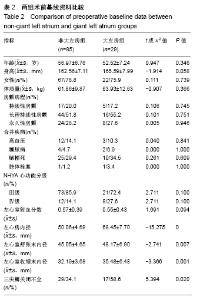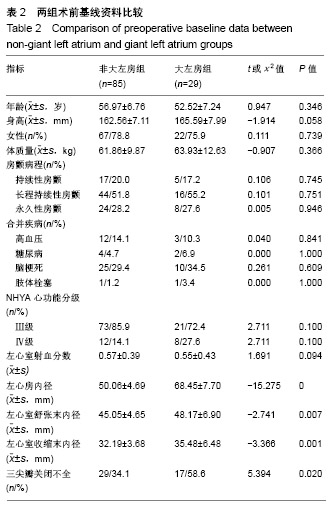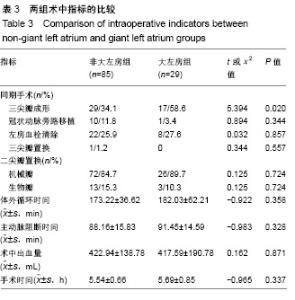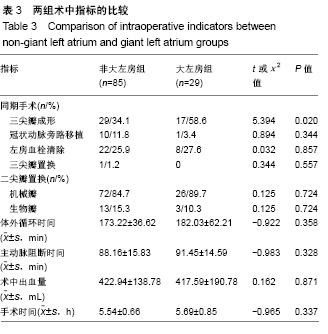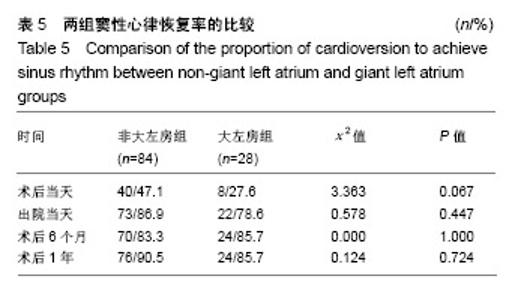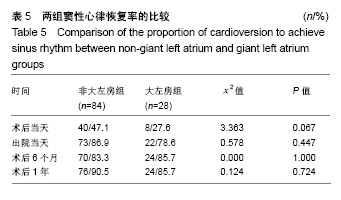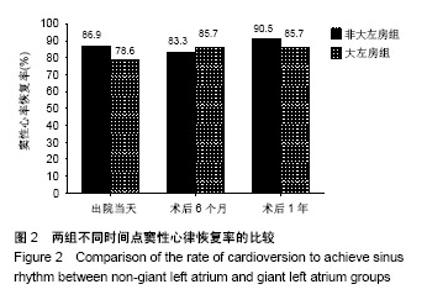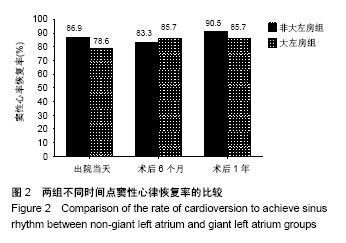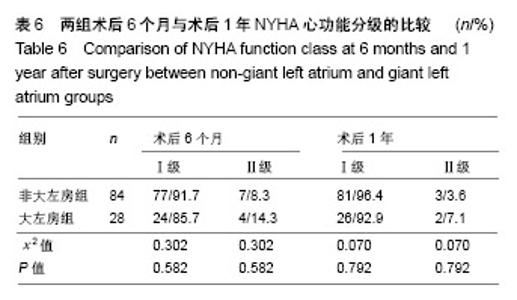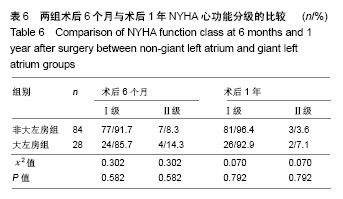Chinese Journal of Tissue Engineering Research ›› 2019, Vol. 23 ›› Issue (26): 4187-4193.doi: 10.3969/j.issn.2095-4344.1358
Previous Articles Next Articles
Cut-and-sew maze procedure and mitral valve replacement in the treatment of atrial fibrillation associated with giant left atrium and rheumatic mitral valve disease
- 1Graduate School, Jinzhou Medical University, Jinzhou 121001, Liaoning Province, China; 2Department of Cardiovascular Surgery, General Hospital of Northern Theater Command, Shenyang 110016, Liaoning Province, China; 3Dalian Medical University, Dalian 116044, Liaoning Province, China
-
Received:2019-04-18 -
Contact:Han Jinsong, MD, Associate chief physician, Master’s supervisor, Department of Cardiovascular Surgery, General Hospital of Northern Theater Command, Shenyang 110016, Liaoning Province, China -
About author:Xie Saiqi, Master candidate, Graduate School, Jinzhou Medical University, Jinzhou 121001, Liaoning Province, China; Department of Cardiovascular Surgery, General Hospital of Northern Theater Command, Shenyang 110016, Liaoning Province, China -
Supported by:the Natural Science Foundation of Liaoning Province (Key Program), No. 20170540977 (to HJS)
CLC Number:
Cite this article
Xie Saiqi, Wang Huishan, Han Jinsong, Yin Zongtao, Han Bing. Cut-and-sew maze procedure and mitral valve replacement in the treatment of atrial fibrillation associated with giant left atrium and rheumatic mitral valve disease[J]. Chinese Journal of Tissue Engineering Research, 2019, 23(26): 4187-4193.
share this article
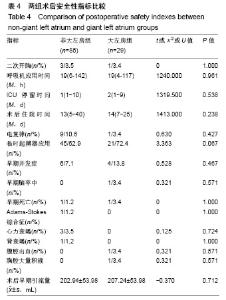
术中安全性指标:两组体外循环时间、主动脉阻断时间、术中出血量、手术时间、机械瓣膜或生物瓣膜二尖瓣置换类型比较差异均无显著性意义(P > 0.05),见表3。 2.5 两组术后安全性指标比较 两组患者术后二次开胸比例、术后行电复律、术后应用临时起搏器比例、呼吸机应用时间、ICU停留时间、术后住院时间、术后早期引流量比较差异均无显著性意义(P > 0.05)。 术后早期并发症:①非大左房组6例出现并发症:1例术后出现Adams-Stokes综合征、3例术后心力衰竭(2例行主动脉内球囊反搏植入术,1例二次气管插管)、1例术后出现肾衰行血液净化、1例术后早期死亡(术后11天多脏器功能衰竭);②大左房组4例出现并发症:1例术后腹腔出血、1例术后出现两侧胸腔大量积液、1例患者术后多次发生脑卒中、1例术后早期死亡(术中左室破裂修补,术后5 d多脏器功能衰竭)。两组术后早期出现并发症比例比较差异无显著性意义(P > 0.05),见表4。"
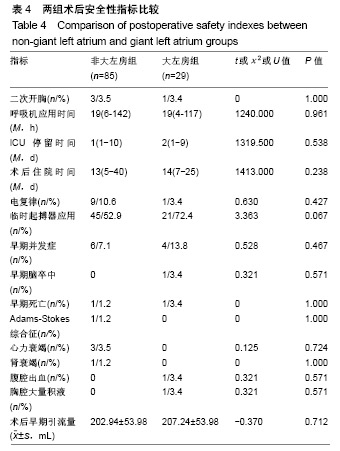
| [1]Sims JB,Roberts WC.Comparison of findings in patients with versus without atrial fibrillation just before isolated mitral valve replacement for rheumatic mitral stenosis(with or without associated mitral regurgitation).Am J Cardiol. 2006;97(7): 1035-1038.[2]邬晓臣,张近宝,欧阳辉,等.二尖瓣置换同期行双极射频消融术治疗风湿性二尖瓣病变合并心房颤动的疗效分析[J].中国胸心血管外科临床杂志,2014;21(6):827-829.[3]Chugh SS,Havmoeller R,Narayanan K,et al.Worldwide epidemiologyof atrial fibrillation:a Global burden of Disease 2010 Study.Circulation.2014;129(8):837-847.[4]Stulak JM,Dearani JA,Sundt TM,et al.Superiority of cut-and -sew technique for the Cox maze procedure: Comparison with radiofrequency ablation.J Thorac Cardiovasc Surg. 2007;133(4):1023-1027.[5]韩劲松,王辉山,汪曾炜,等.人工瓣环置入和迷宫Ⅲ型手术治疗退行性二尖瓣环扩张伴发心房颤动[J].中国组织工程研究, 2015, 19(52):8522-8528.[6]Stulak JM,Dearani JA,Sundt TM,et al.Ablation of Atrial Fibrillation: Comparison of Catheter-Based Techniques and the Cox-Maze III Operation.Ann Thorac Surg. 2011;91(6): 1882-1889.[7]Funatsu T,Kobavashi J,Nakajima H,et al.Long-term results and reliability of cryothermic ablation based maze procedure for atrial fibrillation concomitant with mitral valve surgery.Eur J Cardiothorac Surg.2009;36(2):267-271.[8]崔永强,孟旭,李岩,等.心脏直视手术中双极射频消融治疗心房颤动91例分析[J].中华外科杂志,2009,47(7):533-536.[9]王辉山,汪曾炜,李新民,等.141例心脏手术同期施行双极射频迷宫手术治疗心房颤动[J].中华胸心血管外科杂志, 2009,25(6): 371-374.[10]Garcia-Villarreal OA.Cox-maze III procedure for atrial fibrillation. A preliminary study.Arch Cardiol Mex. 2016;86(3):208-213.[11]Garcia-Villarreal OA.Cox maze III procedure: the best alternative in surgery for atrial fibrillation.J Thorac Cardiovasc Surg.2014;148(1):368-369.[12]Stulak JM,Suri RM,Burkhart HM,et al.Surgical ablation for atrial fibrillation for two decades: Are the results of new Techniques equivalent to the Cox maze III procedure?J Thorac Cardiovasc Surg.2014;147(5):1478-1487.[13]Doty JR,Doty DB,Jones KW,et al.Comparison of standard Maze III and radiofrequency Maze operations for treatment of atrial fibrillation.J Thorac Cardiovasc Surg. 2007;133(4): 1037-1044.[14]韩劲松,王辉山,汪曾炜,等.Cox迷宫III型手术治疗风湿性二尖瓣病变伴发心房颤动的安全性和有效性[J].中华医学杂志, 2016, 96(13):1011-1015.[15]Wang H,Han J,Wang Z,et al.A prospective randomized trial of the cut-and-sew Maze procedure in patients undergoing Surgey for rheumatic mitral valve disease.J Thorac Cardiovasc surg.2018;155(2):608-617.[16]Di Eusanio G,Gregorini R,Mazzola A,et al.Giant left atrium and mitral valve replacement:risk factor analysis.Eur J Cardiothorac Surg.1988;2(3):151-159.[17]Rajagopal S,Rajagopal L,Nair M,et al.Radiofrequency catheter ablation in a patient with giant left atrium and permanent atrial fibrillation: maintenance of sinus rhythm at 1 year.Indian Heart J.2008;60(3):257-259.[18]Gillinov AM,Gelijns AC,Parides MK,et al.Surgical Ablation of atrial fibrillation during mitral-valve surgery.N Engl J Med. 2015;372(15):1399-1409.[19]Ad N,Henry L,Hunt S,et al.Should surgical ablation for atrial fibrillation be performed in patients with a significantly enlarged left atrium?J Thorac Cardiovasc surg. 2014;147(1):236-241.[20]Kim HJ,Kim JB,Jung SH,et al.Surgical ablation of atrial fibrillation in patients with a giant left atrium undergoingmitral valve surgery.Heart.2016;102(15):1206-1214.[21]Marui A,Tambara K,Tadamura E,et al.A novel approach to restore atrial function after the maze procedure in patiens with an enlarged left atrium.Eur J Cardiothorac Surg. 2007;32(2): 308-312.[22]Sunderland N,Nagendran M,Maruthappu M,et al.In patients with an enlarged left atrium does left atrial size reduction improve maze surgery success?Interact Cardiovasc Thorac Surg.2011;13(6):635-641. [23]Kim YG,Shim J,Oh SK,et al.Different responses of left atrium and left atrial appendage to radiofrequency catheter ablation of atrial fibrillation:a follow up MRI study. Sci Rep. 2018;8(1):7871.[24]Burstein B,Nattel S.Atrial Fibrosis: Mechanisms and Clinical Relevance in Atrial Fibrillation.J Am Coll Cardiol. 2008;51(8): 802-809.[25]Iwasaki YK,Nishida K,Kato T,et al.Atrial fibrillation pathophysiology:implications for management. Circulation. 2011;124(20):2264-2274.[26]Kosakai Y.Treatment of atrial fibrillation using the Maze procedure:the Japanese experience.Semin Thorac Cardiova Surg.2000;12(1):44-52.[27]Pande S,Agarwal SK,Mohanty S,et al.Effect of mitral valve replacement on reduction of left atrial size.Asian Cardiovas Thorac Ann.2013;21(3):288-292.[28]Ad N,Henry L,Hunt S,et al.DO we increase the operative risk by adding the Cox Maze III procedure to aortic valve replacement and coronary artery bypass surgery?J Thorac Cardiovasc Surg.2012;143(4):936-944.[29]Louagie Y,Buche M,Eucher P,et al.Improved patient survival with concomitant Cox Maze III procedure compared with heart surgery alone.Ann Thorac Surg.2009;87(2):440-446.[30]王辉山,汪曾炜,尹宗涛,等.Cox迷宫III手术治疗心脏瓣膜病合并持续性房颤[J].中国胸心血管外科杂志,2015,31(12):743-747.[31]Park JH,Shin SH,Lee MJ.Clinical and Echocardiographic Factors Affecting Tricuspid Regurgitation Severity in the Patients with Lone Atrial Fibrillation.J Cardiovasc Ultrasound. 2015;23(3):136-142. |
| [1] | Zhang Wenwen, Jin Songfeng, Zhao Guoliang, Gong Lihong. Mechanism by which Wenban Decoction reduces homocysteine-induced apoptosis of myocardial microvascular endothelial cells in rats [J]. Chinese Journal of Tissue Engineering Research, 2021, 25(5): 723-728. |
| [2] | Xu Hui, Kang Bingxin, Zhong Sheng, Gao Chenxin, Zhao Chi, Qiu Guowei, Sun Songtao, Xie Jun, Xiao Lianbo, Shi Qi. Pressing local acupoints plus adjustion of the knee joint in a sitting position for treating knee osteoarthritis: a randomized controlled trial [J]. Chinese Journal of Tissue Engineering Research, 2021, 25(2): 216-221. |
| [3] | Li Jie, Xu Jianzhen, Hu Ping, Lei Qiqi, Zhang Wenning, Ao Ningjian . Preparation and performance evaluation of carboxymethyl chitosan/oxidized glucomannan/Panax notoginseng compound sponge dressing for chronic wound [J]. Chinese Journal of Tissue Engineering Research, 2021, 25(16): 2528-2534. |
| [4] | Liu Pengran, Jiao Rui, Tao Jin, Chen Hui, Dai Jihang, Yan Lianqi. Comparison of the effects of total hip arthroplasty with different interface prostheses in the treatment of elderly hip diseases [J]. Chinese Journal of Tissue Engineering Research, 2021, 25(15): 2347-2351. |
| [5] | Lai Shuaiwei, Zhang Shasha, Liu Xiaoyun, Haniya Mazhar, Amber Naz, He Lin, Zhu Hongxin. Ultraviolet resistance-associated gene (Uvrag) deficiency promotes cellular senescence in the heart [J]. Chinese Journal of Tissue Engineering Research, 2021, 25(14): 2241-2246. |
| [6] | Mao Xin, Yu Limei, Wang Feng. Important role of mesenchymal stem cells in immune tolerance induction in heart transplantation [J]. Chinese Journal of Tissue Engineering Research, 2021, 25(13): 2070-2078. |
| [7] | Li Hang, Jing Ya, Li Yunhua, Li Hairong, Yang Yanping. A downtrend of mesenchymal cells derived from the second heart field and cardiac neural crest in the outflow tract of Cx43 knockout embryonic mouse heart [J]. Chinese Journal of Tissue Engineering Research, 2021, 25(13): 2018-2024. |
| [8] | Ma Long, Tan Xiaoxin, Sun Guoshao. A 5-year follow-up on sagittal alignment and radiological outcomes of consecutive three-level anterior cervical discectomy and fusion and hybrid surgery [J]. Chinese Journal of Tissue Engineering Research, 2021, 25(12): 1879-1885. |
| [9] | Wang Hongshu, Han Shen, Liu Zu, Li Xiaofang, Zhong Chongbin, Li Lifeng, Li Yaxiong, Jiang Lihong. Transcription factor NKX2-5: molecular structure and biological function in regulating cardiovascular precursor cells [J]. Chinese Journal of Tissue Engineering Research, 2021, 25(1): 108-115. |
| [10] | Wei Yashu, Liu Hongjing, Wang Huifeng, Wang Junduo, Zhao Wenjing, Chen Weiping. Cardiomyocyte-like differentiation of bone marrow mesenchymal stem cells induced by myocardial tissue lysates from different parts of the myocardium [J]. Chinese Journal of Tissue Engineering Research, 2021, 25(1): 32-37. |
| [11] | Jing Yucheng, Wang Le, Wang Xianyun, Wei Mei, Li Min, Ji Lishuang, Ma Fangfang, Liu Gang , Zheng Mingqi. Umbilical cord mesenchymal stem cell transplantation in the treatment of ischemic heart disease: a 3-year follow-up [J]. Chinese Journal of Tissue Engineering Research, 2021, 25(1): 6-12. |
| [12] | Ge Su, Zou Xiaobao, Ma Xiangyang, Wang Binbin, Yang Haozhi, Zhang Shuang, Ni Ling, Chen Yuyue, Xia Hong, Wu Zenghui. Design and application of fulcrum screws for atlantoaxial dislocation [J]. Chinese Journal of Tissue Engineering Research, 2020, 24(9): 1348-1352. |
| [13] | Jiang Biantong, Zhang Zhigang, Jin Xiu, Wang Haiye, Wu Yuchen, Zhang Caiyun. Effects of different calcium supplementation pathways on calcium ion in calcium-free regional citrate anticoagulation-continuous renal replacement therapy: study protocol for a prospective randomized cross-over trial [J]. Chinese Journal of Tissue Engineering Research, 2020, 24(5): 726-730. |
| [14] | Xie Xiufeng, Zhang Yue, Qu Ze. Clinical outcomes of drug-eluting balloons and drug-eluting stents for the treatment of in-stent restenosis [J]. Chinese Journal of Tissue Engineering Research, 2020, 24(4): 555-560. |
| [15] | Li Kaiming, Wang Shangquan, Li Linghui, Zhu Liguo, Zhang Qing, Xie Rui. Bone filling bag vertebroplasty and percutaneous kyphoplasty for the treatment of thoracolumbar osteoporotic compression fractures: a meta-analysis of improving Cobb angle and reducing bone cement leakage [J]. Chinese Journal of Tissue Engineering Research, 2020, 24(4): 650-656. |
| Viewed | ||||||
|
Full text |
|
|||||
|
Abstract |
|
|||||
